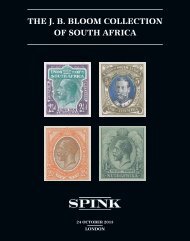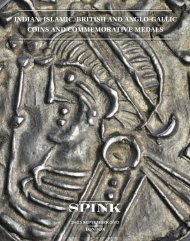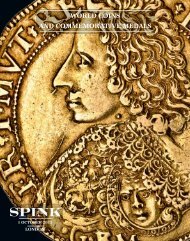bentley priory - Spink
bentley priory - Spink
bentley priory - Spink
Create successful ePaper yourself
Turn your PDF publications into a flip-book with our unique Google optimized e-Paper software.
September 6, 2012 - LONDON<br />
52<br />
Marshal of the Royal Air Force Sir Arthur<br />
‘Bomber’ Harris’s Final Log Book<br />
Pilot’s Flying Log Book, inscribed on front cover in Sir<br />
Arthur’s hand ‘A.C.M. Sir A.T. Harris’, the inner page<br />
similarly named; the entries on the following pages<br />
state: ‘July 1944’ [Aircraft Type] ‘Stinson Sentinal<br />
45’, [Pilot or 1st Pilot] ‘Sir A.T. Harris, A.C.M.’;<br />
[Duty] ‘HQBC Lacey Green - Air HQ Bentley Priory,<br />
return daily’; [Total Hours] ‘17:10’; with similar<br />
entries for ‘August- 17:05’; ‘September- 2:00’; and<br />
‘October- 0:45’- on this last occasion a ‘Messenger<br />
M38’ was used.<br />
£600-800<br />
Marshal of the Royal Air Force Sir Arthur Travers<br />
‘Bomber’ Harris, Bt., G.C.B., O.B.E., A.F.C., was born at<br />
Cheltenham in 1892, and served in South West Africa as a<br />
Private with the Rhodesia Regiment on the outbreak of the<br />
Great War. Returning to England in 1915, he learned to fly<br />
at Brooklands, earned his licence, and joined the Royal Flying<br />
Corps as a 2nd Lieutenant. He served in France and returned<br />
to England in 1918 to command a Home Defence Unit<br />
where he pioneered night fighting, and received the Air Force<br />
Cross later that year.<br />
Granted a permanent commission after the War as a<br />
Squadron Leader in the Royal Air Force, Harris was given the<br />
command of No.3 Squadron in India in 1921, before being<br />
appointed to command No.45 Squadron in Iraq. In 1925 he<br />
was appointed to command No.58 (Bomber) Squadron, and<br />
was created an Officer of the Order of the British Empire in<br />
1927. Employed on staff duties in the Middle East from<br />
1930, in 1932 he commanded the R.A.F. long distance flight<br />
from Cairo to East Africa and back. During these early days<br />
he always took the opportunity to advocate the use of aircraft<br />
for aerial bombing thus displacing the historically based<br />
warship for defensive purposes.<br />
On the advent of the Second World War Harris commanded<br />
No.5 Bomber Group until being appointed Deputy Chief of<br />
Air Staff in November 1940. In May the following year, now<br />
advanced to Air Marshal, he led the R.A.F. Delegation to the<br />
United States of America and in February was appointed head<br />
of Bomber Command- now was the time for Harris to test his<br />
theories. His first initial objective was to organise the 1,000<br />
Bomber Raids on Germany, the first being on Cologne, the<br />
second on Essen, and the third on Bremen. Each of these<br />
raids caused varying destruction and dislocation of the<br />
German Military, Industrial, and Economic systems, and<br />
assisted in the undermining of the German people.<br />
In just under a year Bomber Command, under the leadership<br />
of Harris, almost destroyed seventeen towns and cities, and<br />
severely damaged an equal number. Harris was created a<br />
Knight Grand Cross of the Order of the Bath in 1945, and<br />
was advanced to Marshal of the Royal Air Force in January<br />
1946. It may be stated that Bomber Command’s<br />
contribution to the War effort under Sir Arthur Harris<br />
considerably hastened the end of the Second World War.<br />
During April 1944, Bomber Command was diverted from its<br />
strategic bombing offensive over Germany to support the<br />
preparations for the D-Day landings in Normandy, a role that<br />
Marshal of the Royal Air Force Sir A.T. Harris<br />
it shared with the USAAF 8th Air Force. Overall<br />
responsibility for the air campaign in support of the landings<br />
in France was Air Chief Marshal Sir Trafford Leigh-Mallory,<br />
the Air Commander-in-Chief of the Allied Expeditionary Air<br />
Force.<br />
Planning for the air aspects of D-Day operations was carried<br />
out at Bentley Priory, the Headquarters of Air Defence of<br />
Great Britain (Fighter Command). The various air<br />
commanders of the participating commands met regularly<br />
during the planning phase. These meetings became<br />
increasingly frequent as D-Day approached and in the period<br />
following the invasion. To allow easier, and more secure,<br />
travel an airstrip was constructed in the grounds of Bentley<br />
Priory which could accommodate light communications<br />
aircraft such as the Auster, Stinson, and Messenger.<br />
The nearest airfield to HQ Bomber Command was some<br />
distance away so some agricultural land was commandeered<br />
at Lacey Green, just a few hundred yards from Harris’s<br />
headquarters. Over the next few weeks he made regular<br />
flights from the strip to the various Allied Headquarters in<br />
the south-east of England, in particular to Bentley Priory.<br />
One report stated, ‘The usual procedure was daily flights with<br />
a 10.30 am take off, returning about 1 pm with ACM Sir<br />
Arthur Harris at the controls of his personal aircraft, which<br />
was a Stinson high wing mono-plane’. In mid-September,<br />
Bomber Command was formally released from control by the<br />
Supreme Headquarters Allied Expeditionary Force when it<br />
reverted to Air Ministry control.<br />
113

















